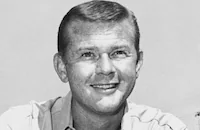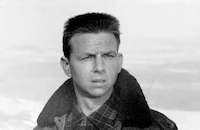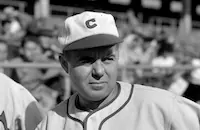Battle Zone

Brief Synopsis
Cast & Crew
Lesley Selander
John Hodiak
Linda Christian
Stephen Mcnally
Martin Milner
Dave Willock
Film Details
Technical Specs

Synopsis
On July 20, 1950 at the Camp Pendleton, California Marine Corps Training Area, newsreel cameraman Master Sgt. Danny Young returns to active duty in the Korean War. Although he has not seen his friend Sgt. Mitch Turner in two years, Danny immediately reignites their rivalry by mocking Mitch for shooting military documentaries instead of the more dangerous combat films. Corp. Andy Sayer is awed to meet Danny, who is highly decorated for his daring work and is now on a special government assignment. The next day, Mitch trains his new recruits at the Motion Picture Production Unit, explaining that films that seem boring, such as reels of tide patterns, are just as important to military strategy as battle footage. Outside, Danny is thrilled to be invited to dinner by his ex-girl friend Jeanne, an Italian Red Cross nurse whom Danny met during World War II. That evening, however, he is furious to hear that Jeanne is now engaged to Mitch. She informs him that she forgave him for cheating on her in Europe, and when she was assigned to America, she looked for him but found only Mitch, and they soon fell in love. Danny storms out of the restaurant, and although he later tries to apologize, she refuses to answer his messages. He is just about to visit her when Mitch informs the troops that they are shipping out to Korea. As the troops board the carriers, Mitch, who is filming the transport, spots Danny talking to Jeanne, who walks away from him. Within days, the troops join the other Marines and United Nations combat forces in South Korea. Their support soon wins the battle, and Danny photographs the Koreans surrendering while Mitch films the cooks, to provide families back home with images of their boys eating hot meals. Danny, who has his own Jeep and driver, informs Mitch that Jeanne will arrive in Seoul the following day. Danny beats Mitch to Seoul by hours and there lies to Jeanne that Mitch wants to meet her for lunch. By the time Mitch arrives, he finds them eating together and jealously demands that Jeanne leave with him. In the morning, Danny discovers that Mitch has cancelled his wake-up call and commandeered the Jeep in order to reach the battle area first. Danny, however, requisitions a helicopter and beats Mitch to the front, where they eventually shoot side by side. When they receive their next orders to travel north to snow country, Danny announces he will stay behind, knowing that Jeanne's unit will soon be coming through. Although everyone believes that the war is close to ending, they soon learn that the Chinese Army has joined the South Korean troops and the area towns will be evacuated. Danny photographs the evacuees and then joins Mitch's troops in the north, bearing gifts from the city. After discussing the fact that United States intelligence may take weeks to uncover Chinese plans, Mitch wakes Danny in the middle of the night to inform him that he is taking Andy, Corp. Smitty and a Korean translator past enemy lines to gather intelligence. As Mitch had predicted, Danny insists on coming along, and just before they leave, a group of soldiers assigned to protect them also joins them. Disguised as Koreans, they infiltrate the Chinese area and take photographs that are carried to Army headquarters by runners. Although Danny grumbles that the photographs show nothing, the colonel quickly discerns hidden artillery ranges in them. One night, the exhausted team takes over a local farmhouse, not realizing that one of their runners is a spy who has raced to the Chinese to divulge their location. They are ambushed, and although the Americans emerge victorious, Andy is killed. Upon discovering that their new prisoners have a Chinese truck, the Americans use it as camouflage to gain entrance to, and then photograph, the Chinese headquarters. As they prepare to leave, they are discovered and, at a roadblock, are forced to drop out of the truck and hide from tank gunners. They escape, but Danny's arm is nicked by a bullet. During the two-day walk back to their unit, Danny admits to Mitch that even the dull pictures were important to the war effort. At the camp, Danny cedes full credit for the mission to Mitch and is ministered to by Jeanne, whose outfit has joined the Marine battalion. When Mitch thanks him, Danny informs him that he plans to stay behind with Jeanne while the troops return to combat. Disappointed that Danny has not changed, Mitch prepares to travel on. As the troops leave, Danny tries once more to seduce Jeanne, and when she again turns him down, he finally realizes how much she loves Mitch, and races to catch up to the troops. He spots Mitch on the road and, pulling up in his Jeep, invites him to hop in.

Director
Lesley Selander
Cast

John Hodiak

Linda Christian

Stephen Mcnally

Martin Milner
Dave Willock
Jack Larson
Richard Emory
Philip Ahn
Carleton Young
John Fontaine
Todd Karnes

Gil Stratton Jr.
John Close
Dale Hutchinson

Russ Conway
John Pickard
Harry Lauter
Freeman Fowler

Charles Buchinsky
George Conrad
Julian Upton
Lee Turnbull
Frank Stanlow

Gregory Walcott
Herb Jacobs
Peter Adams
Tom Irish
Grady Galloway
Bob Nichols
Joel Marston
Bob Sanford

Alvy Moore
Lee Graham
Bill Lechner
Bill Cabanne
Roger Mcgee
Lee Choon Wha
Owen Song

Dorothy Patrick

Ray Walker
Crew
Boyd Blackburn
William A. Calihan Jr.
Leon Charles
Charles Cooper
Steve Fisher
Dan Greenway
Henry Hartman
Augie Lohman
Ray Mercer
Ernest Miller
David Milton
Jack Ogilvie
Gordon Otto
Robert Priestley
Lester A. Sansom
Marlin Skiles
Captain John M. Terry Usmc
Walter Wanger
Joe Wonder
Allen K. Wood

Videos
Movie Clip


Film Details
Technical Specs

Articles
Battle Zone
A Korean War story, it cast Hodiak and Stephen McNally as Marine combat photographers -- former WWII buddies and friendly rivals who are immersed in combat but also develop a romantic triangle with a Red Cross nurse played by Linda Christian. The film was shot in two weeks at a cost of $200,000.
Allied Artists was a unit of Monogram Pictures that made somewhat costlier films than typical Monogram fare, and at this point Allied had a new policy of using more prominent names in its main roles. Hodiak and McNally actually made for a pretty strong cast for an Allied Artists title. Also, right around the time this film was made in the summer and fall of 1952, Monogram was transitioning entirely to the Allied Artists name.
Battle Zone bears the name of Walter Wanger as producer even though he had nothing to do with making it. The longtime, respected producer had just been embroiled in one of Hollywood's biggest scandals and was actually in prison. In 1951, he had shot agent Jennings Lang in the groin after discovering that Jennings was having an affair with Wanger's wife, actress Joan Bennett. He pled insanity and was sentenced to four months in prison; he served 98 days. (When he was released, he was so appalled by the prison conditions that he made Riot in Cell Block 11 [1954], a first-rate prison drama that also functioned as a personal appeal for prison reform.)
But while Wanger was in prison, Monogram, his current employer, produced three genre films -- Fort Vengeance (1953), Kansas Pacific (1953), and Battle Zone -- and gave Wanger credit, salary, and profit participation for all three. Partly this was because the studio saw value and prestige in having Wanger's name in the credits. But it was also because, as Allied Artists executive producer Walter Mirisch said, "It was something we did for a friend in trouble." When Wanger got out of prison, he had $86,000 waiting for him from these films.
Battle Zone caused no great shakes upon release. Critics deemed it average at best, though some praised the film's use of actual documentary combat footage, integrated with the staged scenes, as making the picture look and feel bigger than it really was. The New York Times, on the other hand, thought the transitions between the two were poorly done.
A few weeks after the movie opened, Hodiak's wife, actress Anne Baxter, filed for divorce. They had first met and started dating on the set of Sunday Dinner for a Soldier (1944), and married five years later. Hodiak made only a handful more films as he died suddenly in 1955, at the age of 41, of a coronary thrombosis.
Linda Christian was best known for her turbulent marriage to heartthrob Tyrone Power, Jr. Critics echoed each other in their assessment of her work here, with The New York Times calling her "very attractive but dull," and Variety proclaiming, "Miss Christian is okay, although scoring more on looks than thespic expressiveness."
Battle Zone opened one day after the bigger-budget The Happy Time (1952), which also featured Linda Christian.
By Jeremy Arnold
SOURCES:
Matthew Bernstein, Walter Wanger: Hollywood Independent
Karen Burroughs Hannsberry, Bad Boys: The Actors of Film Noir

Battle Zone
TCM Remembers Charles Bronson - Sept. 13th - TCM Remembers Charles Bronson this Saturday, Sept. 13th 2003.
Turner Classic Movies will honor the passing of Hollywood action star Charles Bronson on Saturday, Sept. 13, with a four-film tribute.
After years of playing supporting roles in numerous Western, action and war films, including THE MAGNIFICENT SEVEN (1960, 8 p.m.) and THE DIRTY DOZEN (1967, 1:15 a.m.), Bronson finally achieved worldwide stardom as a leading man during the late 1960s and early 1970s. TCM's tribute will also include THE GREAT ESCAPE (1963, 10:15 p.m.), Bronson's second teaming with Steve McQueen and James Coburn, and will conclude with FROM NOON TILL THREE (1976, 4 a.m.), co-starring Jill Ireland. TCM will alter it's prime-time schedule this Saturday, Sept. 13th. The following changes will take place: 8:00 PM - The Magnificent Seven (1960)10:15 PM - The Great Escape (1963)
1:15 AM - The Dirty Dozen (1967)
4:00 AM - From Noon Till Three (1976) Charles Bronson, 1921-2003
Charles Bronson, the tough, stony-faced actor who was one of the most recognizable action heroes in cinema, died on August 30 in Los Angeles from complications from pneumonia. He was 81.
He was born Charles Buchinsky on November 3, 1921 in Ehrenfeld, Pennsylvania, one of fifteen children born to Lithuanian immigrant parents. Although he was the only child to have graduated high school, he worked in the coalmines to support his family until he joined the army to serve as a tail gunner during World War II. He used his money from the G.I. Bill to study art in Philadelphia, but while working as a set designer for a Philadelphia theater troupe, he landed a few small roles in some productions and immediately found acting to be the craft for him.
Bronson took his new career turn seriously, moved to California, and enrolled for acting classes at The Pasadena Playhouse. An instructor there recommended him to director Henry Hathaway for a movie role and the result was his debut in Hathaway's You're in the Navy Now (1951). He secured more bit parts in films like John Sturges' drama The People Against O'Hara (1951), and Joseph Newman's Bloodhounds of Broadway (1952). More substantial roles came in George Cukor's Pat and Mike (1952, where he is beaten up by Katharine Hepburn!); Andre de Toth's classic 3-D thriller House of Wax (1953, as Vincent Price's mute assistant, Igor); and De Toth's fine low-budget noir Crime Wave (1954).
Despite his formidable presence, his leads were confined to a string of B pictures like Gene Fowler's Gang War; and Roger Corman's tight Machine Gun Kelly (both 1958). Following his own television series, Man With a Camera (1958-60), Bronson had his first taste of film stardom when director Sturges casted him as Bernardo, one of the The Magnificent Seven (1960). Bronson displayed a powerful charisma, comfortably holding his own in a high-powered cast that included Yul Brynner and Steve McQueen. A few more solid roles followed in Sturges' The Great Escape (1963), and Robert Aldrich's classic war picture The Dirty Dozen (1967), before Bronson made the decision to follow the European trail of other American actors like Clint Eastwood and Lee Van Cleef. It was there that his hard, taciturn screen personae exploded in full force. In 1968 alone, he had four hit films: Henri Verneuil's Guns for San Sebastian, Buzz Kulik's Villa Rides, Jean Herman's Adieu l'ami which was a smash in France; and the classic Sergio Leone spaghetti Western Once Upon a Time in the West.
These films established Bronson as a huge box-office draw in Europe, and with some more stylish hits like Rene Clement's Rider on the Rain (1969), and Terence Young's Cold Sweat (1971) he soon became one of the most popular film stars in the world. It wasn't easy for Bronson to translate that success back in his homeland. In fact, his first few films on his return stateside: Michael Winners' Chato's Land, and The Mechanic (both 1972), and Richard Fleischer's Mr. Majestyk (1973), were surprisingly routine pictures. It wasn't until he collaborated with Winner again for the controversial Death Wish (1974), an urban revenge thriller about an architect who turns vigilante when his wife and daughter are raped, did he notch his first stateside hit. The next few years would be a fruitful period for Bronson as he rode on a wave of fine films and commercial success: a depression era streetfighter in Walter Hill's terrific, if underrated Hard Times (1975); Frank Gilroy's charming offbeat black comedy From Noon Till Three (1976, the best of many teamings with his second wife, Jill Ireland); Tom Gries tense Breakheart Pass; and Don Siegel's cold-war thriller Telefon (1977).
Sadly, Bronson could not keep up the momentum of good movies, and by the '80s he was starring in a string of forgettable films like Ten to Midnight (1983), The Evil That Men Do (1984), and Murphy's Law (1986, all directed by J. Lee Thompson). A notable exception to all that tripe was John Mackenzie's fine telefilm Act of Vengeance (1986), where he earned critical acclaim in the role of United Mine Workers official Jack Yablonski. Although he more or less fell into semi-retirement in the '90s, his performances in Sean Penn's The Indian Runner (1991); and the title role of Michael Anderson's The Sea Wolf (1993) proved to many that Bronson had the makings of a fine character actor. He was married to actress Jill Ireland from 1968 until her death from breast cancer in 1990. He is survived by his third wife Kim Weeks, six children, and two grandchildren.
by Michael T. Toole
TCM Remembers Charles Bronson - Sept. 13th - TCM Remembers Charles Bronson this Saturday, Sept. 13th 2003.
Quotes
Trivia
Notes
The film begins with the following written foreword: "We desire to express grateful appreciation to the Department of Defense and the United States Marine Corps, for the cooperation which was extended in the production of this picture. We especially salute the men and officers of Camp Pendleton, California, where many of the sequences were filmed." At the end of the film, the following narration is heard: "Wherever the United States Marines are fighting our nation's battles, whether by land, sea or air, the Marine combat cameraman will be bound. He is a fighting man, using a camera as well as a gun in one of the finest combat forces in the world. To him, we respectfully dedicate this picture." According to an October 1952 Hollywood Citizen-News item, some of the battle footage in the film was taken from Korean War documentary films.














